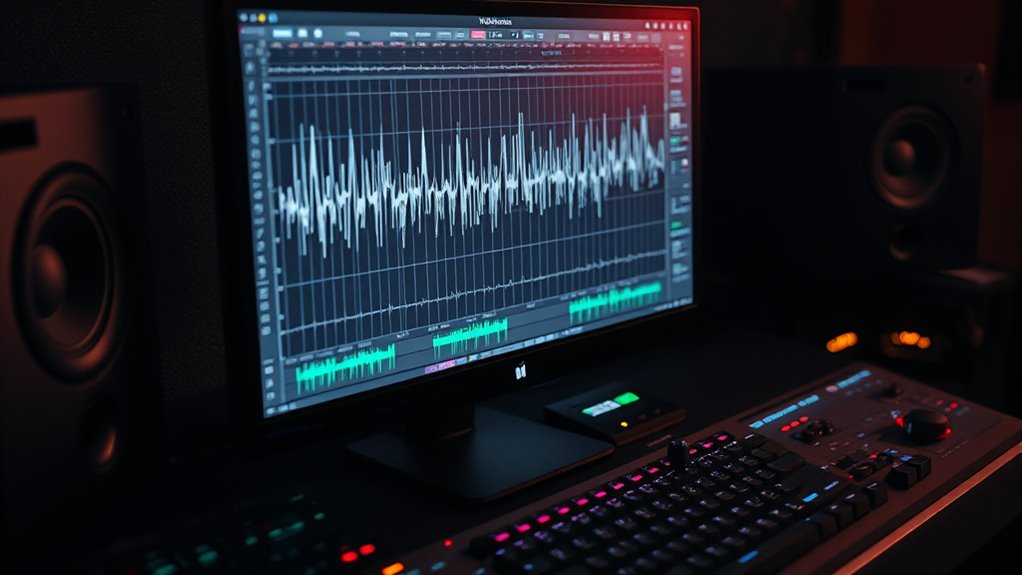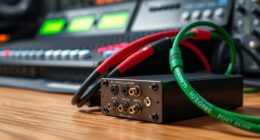To de-ess dark vocals without relying solely on a plugin, try using advanced EQ techniques like narrow cuts around harsh frequencies and gentle boosts to maintain tone. Incorporate dynamic processing such as multiband compression or sidechain compression to target sibilance peaks naturally. Manual editing, like volume automation and spectral repair, fine-tunes the response. Additionally, harmonic enhancement from exciters or saturation can mask harshness while preserving warmth. Explore these strategies to achieve a clean, natural sound—you’ll discover how to craft the perfect vocal balance.
Key Takeaways
- Use precise EQ cuts around 5-8 kHz to target harsh sibilant frequencies without dulling the overall tone.
- Apply manual volume automation during sibilant peaks to reduce harshness while maintaining vocal warmth.
- Incorporate dynamic EQ or multiband compression to automatically tame transient sibilance without affecting natural sound.
- Enhance harmonic content with gentle saturation or exciters to obscure harsh frequencies subtly.
- Optimize microphone placement and room acoustics during recording to minimize sibilance at the source.
Understanding the Nature of Dark Vocals and Sibilance

Dark vocals often carry a rich, warm tone that can add depth to a mix, but they also tend to produce more sibilance—those sharp “s” and “sh” sounds—that can become harsh or distracting. Understanding the vocal tone is key to managing this balance. Dark vocals typically have less brightness and more lower-mid frequencies, which contribute to their full, resonant quality. However, this warmth can exaggerate sibilance characteristics, making sibilant sounds stand out more prominently. These sharp sibilant sounds can cut through the mix, drawing unwanted attention. Recognizing the natural sibilance tendencies of dark vocals helps you identify where to focus your de-essing efforts. By understanding how vocal tone influences sibilance, you can develop effective strategies to control harshness without sacrificing vocal warmth. Additionally, employing sound therapy principles can aid in achieving a balanced vocal tone and reducing harsh sibilance.
Using Creative EQ Techniques to Reduce Harshness

You can tame harshness by applying narrow band cuts in specific frequency ranges where the sibilance or brightness peaks. Using dynamic EQ allows you to target these problematic areas only when they become overly harsh, preserving the natural tone of the vocals. Experimenting with these creative EQ techniques helps achieve a balanced, smooth sound without sacrificing clarity. Additionally, exploring sound editing techniques can further refine the vocal tone and reduce unwanted brightness.
Narrow Band Cuts
Have you ever noticed that reducing harshness in dark vocals often requires pinpoint precision? Narrow band cuts are your go-to tool for this. By using bandwidth narrowing, you focus on specific problem frequencies without affecting the rest of the sound. Frequency carving allows you to target harsh sibilant or nasal areas precisely. Here are some tips:
- Identify the harsh frequency range with a narrow Q setting.
- Use bandwidth narrowing to isolate problem frequencies.
- Make subtle cuts—avoid overdoing it to keep natural tone.
- Sweep through carefully to find the exact spot where harshness peaks.
- Remember that traditional butter making techniques, like precise adjustments, have long been valued for their effectiveness—applying similar care to your EQ adjustments can yield better results.
This technique ensures you carve out harshness without dulling the overall vocal presence. With patience, narrow band cuts can considerably improve dark vocals, making them smoother and more balanced.
Dynamic EQ Application
After narrowing down problem frequencies with static cuts, dynamic EQ brings a new level of control by responding automatically to harshness as it occurs. It targets specific moments when sibilance or harsh vocals emerge, preventing over-processing. Using dynamic EQ, you can address issues like frequency masking, where harsh sounds clash with other elements, without dulling the entire vocal. It also aids in harmonic balancing, smoothing out overly bright peaks while preserving natural brightness. For example, setting a dynamic band around 5-8 kHz helps tame sibilance only when needed. This approach maintains vocal clarity while reducing harshness. Incorporating offensive security measures in your mixing process can help identify potential issues before they become problematic in the final mix.
Dynamic Processing: Employing Multiband Compression for Nuanced Control

Multiband compression offers a powerful way to control dark vocals with precision by targeting specific frequency ranges. It helps reduce harshness or muddiness without affecting the entire spectrum, allowing for better harmonic balancing. This technique minimizes frequency masking, ensuring clarity and detail in your mix. To get the most out of multiband compression, consider these tips:
- Isolate problem areas like the low-mid range to tame muddiness.
- Use gentle ratios to avoid unnatural sound artifacts.
- Adjust crossover points carefully for seamless frequency division.
- Monitor how each band interacts with others to maintain harmonic balance.
- Paying attention to contrast ratio can also help improve overall vocal clarity by enhancing the depth and separation of different audio elements.
Manual Editing: Precise Volume Automation and Spectral Repair

Manual editing lets you fine-tune vocal levels with precise volume automation, ensuring darker vocals sit perfectly in the mix. You can also use spectral repair techniques to remove residual sibilance or artifacts that remain after processing. Following effective workflow tips helps you stay organized and achieve natural-sounding results efficiently. Additionally, understanding the asset division process can inform your approach to managing and preserving essential elements of your mix during editing.
Precise Volume Control
To achieve natural-sounding de-essing, precise volume control is essential, and this often involves manual editing techniques like volume automation and spectral repair. By carefully adjusting levels, you can target sibilant peaks without affecting the overall vocal tone. Focus on vocal layering to maintain fullness while reducing harshness. Ensuring phase alignment between vocal tracks prevents phase cancellation, keeping your vocals clear and cohesive. Here are some tips:
- Use automation to subtly lower volume during sibilant moments.
- Manually edit clips to smooth out abrupt volume jumps.
- Apply spectral repair to reduce harsh frequencies without affecting the entire vocal.
- Check vocal layering for phase issues, adjusting timing to preserve natural sound.
- Pay attention to room acoustics and microphone placement, as these can influence sibilance and overall sound quality.
This precise control helps you craft a balanced, polished vocal that sounds natural and free of harsh sibilance.
Spectral Restoration Techniques
When it comes to restoring the clarity of dark vocals, precise volume automation and spectral repair are powerful tools in your editing arsenal. Use manual volume automation to carefully reduce inconsistent sibilance or harsh s sounds without affecting the natural tone. Spectral repair tools can target specific problematic frequencies, removing residual sibilance or mic artifacts. Vocal harmonization can help mask minor imperfections by blending complementary vocal layers, reducing the need for aggressive editing. Be cautious of spectral masking, which can unintentionally hide or emphasize certain frequencies, so listen closely to ensure natural results. Combining these techniques allows you to retain vocal warmth while eliminating distracting elements. This meticulous approach ensures your dark vocals stay clear, balanced, and expressive without relying solely on plugins. Additionally, understanding the sound vibrations involved in your recordings can help you identify and address issues more precisely during editing.
Automation Workflow Tips
Achieving natural-sounding dark vocals requires careful and deliberate volume automation combined with spectral repair. Manual editing lets you fine-tune vocal layering and address room acoustics issues that affect clarity. Here are some tips to enhance your workflow:
- Use precise volume automation to smooth out inconsistencies, especially during dynamic passages.
- Identify and manually repair spectral issues caused by room acoustics that create unwanted resonances.
- Automate volume dips during sibilant or harsh sounds to maintain a balanced dark tone.
- Regularly toggle between playback and editing to ensure seamless transitions and consistent vocal presence.
- Incorporate creative studio techniques to further refine your vocal sound and bring a professional polish to your mix.
Employing De-Esser Alternatives Like Exciters or Saturation

Instead of relying solely on a traditional de-esser, you can explore alternatives like exciters or saturation to tame harsh sibilant sounds. These techniques work by subtly adding harmonic distortion or emphasizing certain frequencies, effectively masking problematic sibilance through frequency masking. Exciters boost high-frequency content, which can soften harshness without dulling the vocal’s natural brightness. Saturation introduces controlled harmonic distortion that smooths out sharp sibilant peaks. Both methods can be dialed in carefully to avoid over-processing, maintaining clarity and presence. Unlike a standard de-esser, these options add a musical quality, making sibilance less intrusive while preserving the vocal’s character. Clove oil’s analgesic properties can be beneficial in reducing discomfort during vocal processing. Use them thoughtfully to achieve a natural, polished sound without sacrificing the warmth or detail of your dark vocals.
Adjusting Microphone Placement and Recording Techniques for Future Sessions

Optimizing microphone placement and recording techniques can substantially reduce sibilance issues before they even reach your processing chain. Proper positioning minimizes harsh sibilant sounds at the source. Consider these strategies:
- Place the microphone slightly off-axis from the singer’s mouth to reduce direct sibilant capture.
- Use a directional microphone with a tighter polar pattern to focus on the vocalist’s voice and reject unwanted sounds.
- Experiment with distance; moving the mic back a few inches can soften sibilant peaks.
- Incorporate filtering techniques during recording, such as gentle high-pass filters, to tame overly bright frequencies.
Leveraging Sidechain Compression for Sibilance Management

Leveraging sidechain compression is a powerful method to control sibilance dynamically during mixing. By using sidechain ducking, you can reduce harsh sibilant frequencies only when they spike, preserving natural vocal presence. Set up a compressor with the sibilant frequency range as the sidechain input, allowing it to react specifically to sibilance rather than the entire vocal signal. Frequency ducking targets problematic sibilant sounds directly, reducing their impact at the source. This technique ensures the de-essing process is transparent and musical, avoiding the over-processed sound that can occur with static EQ cuts. Adjust the attack and release times to match the vocal performance, so compression responds smoothly without affecting the vocal’s natural dynamics. Sidechain ducking offers a precise, dynamic solution beyond traditional static de-essing methods.
Utilizing Harmonic Enhancement to Mask Harsh Frequencies

Harmonic enhancement can effectively mask harsh frequencies in dark vocals by adding subtle overtones that blend problematic areas into a richer, more pleasing sound. By applying harmonic saturation, you introduce gentle overtones that naturally fill out the vocal tone, reducing the prominence of harsh frequencies. This technique leverages frequency masking, where added harmonics obscure the problematic areas without overwhelming the core sound.
Harmonic saturation subtly masks harsh frequencies, enriching vocals with warm overtones and smoothness.
To utilize this method:
- Use a harmonic saturator to subtly increase saturation levels.
- Focus on gentle drive to avoid over-processing.
- Blend in the processed signal to maintain naturalness.
- Adjust saturation intensity until harshness diminishes, and warmth increases.
This approach enriches your vocals while controlling unwanted sibilance, making them sound smoother and more balanced.
Applying Subtractive EQ in Conjunction With Reverb and Delay Effects

When applying reverb and delay effects to dark vocals, using subtractive EQ alongside these effects allows you to shape the sound more effectively. Spectral subtraction helps you identify and remove problematic frequencies that may cause muddiness or masking, especially when effects add depth. By cutting specific frequencies before adding reverb or delay, you prevent frequency masking, where certain ranges dominate and obscure others. This approach ensures the reverb remains clear and doesn’t amplify unwanted resonances. Focus on removing harsh or boomy frequencies that conflict with the effect’s space, creating a more transparent, balanced sound. Combining subtractive EQ with effects helps you maintain clarity, control the spectral balance, and achieve a more polished vocal presence without relying solely on processing plugins.
Combining Multiple Strategies for a Transparent and Natural Sound

To achieve a clear and natural vocal sound, you should combine several techniques thoughtfully. Light compression helps control dynamics without sounding obvious, while EQ clarifies the voice by reducing muddiness. Subtle de-essing, when layered with these strategies, guarantees the vocals stay smooth and transparent.
Layering With Light Compression
Layering with light compression can help you achieve a more natural, transparent vocal sound while controlling harshness. It subtly smooths out dynamic variations, preserving vocal texture and ensuring naturalness. This technique also aids in frequency balancing, preventing harsh peaks from dominating the mix. To implement this effectively:
- Use a gentle compressor with a high ratio and slow attack to subtly tame peaks without squashing dynamics.
- Blend the compressed signal with the dry vocal to retain authenticity and avoid over-processing.
- Layer multiple takes or doubled vocals, applying light compression to each for added depth and richness.
- Focus on maintaining vocal clarity, ensuring that the compression enhances, rather than masks, the vocal’s natural tone.
This approach creates a transparent, balanced sound that complements dark vocals without sacrificing expressiveness.
Using EQ for Clarity
Using EQ for clarity involves carefully shaping the vocal tone to enhance transparency and naturalness. Start by identifying frequency masking issues where unwanted overlap causes muddiness, and reduce those problematic areas gently. Focus on harmonic balancing by accentuating the vocal’s core frequencies—typically between 1-4 kHz—to ensure clarity without harshness. Cutting or boosting specific bands helps separate the vocal from other elements, creating space and preventing masking. Use narrow Q settings for precise adjustments, avoiding drastic cuts that could dull the sound. This approach preserves the vocal’s character while achieving a transparent, natural tone. Combining subtle EQ moves with other strategies ensures your vocals sound clean, balanced, and true to the original performance.
Applying Subtle De-essing
Applying subtle de-essing is essential for achieving a natural, transparent vocal sound without introducing artifacts or making the sibilant sounds less intelligible. To do this effectively, combine multiple strategies like frequency masking and harmonic balancing. This approach ensures the sibilance is controlled without sacrificing vocal clarity.
Here are some tips:
- Use gentle EQ boosts around sibilant frequencies to mask harsh sounds subtly.
- Apply harmonic balancing to smooth out sharp transients caused by sibilance.
- Blend de-essing with natural compression to maintain dynamics.
- Adjust levels gradually to prevent over-processing, ensuring the vocal remains transparent and lively.
This combination allows you to finely-tune the de-essing process for a natural, cohesive vocal sound.
Frequently Asked Questions
How Can I Identify Sibilance Issues Before Recording?
To identify sibilance issues before recording, you should focus on sibilance detection during vocal analysis techniques. Listen carefully for harsh “s” and “sh” sounds, especially when the singer hits high notes. Use a mirror or recording device to observe pronunciations, and ask the singer to perform through different vowels. These steps help you catch sibilance early, so you can address it effectively before it becomes a problem in post-production.
What Are the Best Microphone Types for Darker Vocal Tones?
Choosing the right microphone for darker vocals is like finding the perfect pair of shoes—they need to fit comfortably and suit your style. Condenser mics with a warmer tone, like large-diaphragm models, work well. Use careful microphone placement to avoid harshness, and employ pop filter techniques to reduce plosive sounds. This combo helps capture the depth of your voice without unwanted sibilance, making your vocals sound rich and smooth.
Can Vocal Layering Help Reduce Harshness in Dark Vocals?
Vocal layering can definitely help reduce harshness in dark vocals. By adding vocal harmonization, you create tonal balancing, which smooths out any harsh frequencies. When you blend multiple takes or harmonies, the combined sound softens the darker tones, making them more even and pleasant. This technique not only enhances the overall vocal texture but also minimizes harshness, giving your vocals a more polished and professional feel without relying solely on de-essing plugins.
How Does Room Acoustics Influence Sibilance and Dark Vocals?
Room acoustics markedly influence sibilance and dark vocals. You notice that room reflections can amplify harsh sibilance, making vocals sound sharper or more distorted. To counter this, you can use diffusion techniques to scatter reflections evenly, reducing harshness. Properly treating your space with absorption panels and diffusers helps control how sound interacts within the room, resulting in smoother, darker vocals with less unwanted sibilance.
Are There Specific Vocal Styles More Prone to Sibilance Issues?
Some vocal styles are more prone to sibilance issues, especially whispered vocals and growled singing. Whispered vocals often emphasize sibilant sounds, making them harsher, while growled singing can distort sibilance intensity. You might notice more sibilance in these styles, requiring you to manage it carefully. Adjust your technique or use alternative strategies like careful mic placement and dynamic processing to control sibilance without relying solely on plugins.
Conclusion
By exploring alternative de-essing techniques beyond plugins, you gain more control and transparency in your vocals. Did you know that using creative EQ and dynamic processing can reduce sibilance by up to 60% without sacrificing vocal clarity? Combining these methods allows you to craft a natural, polished sound that sits perfectly in your mix. Experimenting with these strategies empowers you to tame dark vocals effectively while maintaining their emotional impact.










